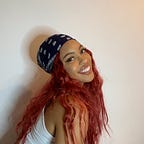Fashion Meets Technology: The Impact of Digital Advancements on Fashion
With AI being the top conversation these days, it's starting to make a mark on the fashion industry.
The recent Nike x Tiffany co. collab was poorly executed and it's clear the brands just want to mint money off both client-ental that are loyal to the brands. An AI tool was used to create possible designs that could have been made out of the collaboration compared to the boring and thoughtless outcome of what was initially released to the public.
Technology is definitely making waves in the fashion industry, and its impact is being felt in every aspect of the business, from design and production to marketing and sales. One of the most significant ways that technology has influenced fashion is through the use of fashion shows. Fashion shows have long been an essential tool for designers to showcase their collections, but with the introduction of new technologies, these events have become even more impactful and exciting.
In the past, fashion shows were limited to a select few attendees and were typically static events. However, with the advancement of technology, designers can now reach a much larger audience and create dynamic, interactive experiences for their fans. For example, many fashion shows are now live-streamed on social media platforms such as Instagram and YouTube, allowing viewers from around the world to tune in and watch in real time. This not only broadens the reach of the show but also creates a sense of immediacy and exclusivity, making it feel like the viewer is actually in the front row of the event.
One of the most exciting ways that technology has impacted fashion shows is through the use of virtual reality. This has allowed designers to create immersive experiences that go beyond what was previously possible. With virtual reality, designers can transport their audience to a completely different world, showcasing their collections in unique and imaginative ways. The Hanifa brand is one of the few brands that popularize the concept of 3D runway shows when the pandemic first began. For example, virtual reality has been used to create interactive runways, where models appear to walk on water or float in the air. This not only captivates the audience but also adds an element of surprise and excitement to the show.
Another way that technology has impacted fashion shows is through the use of augmented reality. Augmented reality allows designers to bring their collections to life in a new way, providing a more interactive experience for the audience. For example, some fashion shows now feature augmented reality displays that allow viewers to see a model walking down the runway in a specific outfit and then interact with that outfit, examining it from different angles and even trying it on virtually. This not only makes the experience more engaging but also allows designers to showcase their collections in a more impactful way.
Technology has also impacted the way that designers approach the production of their collections. In the past, designers had to rely on sketches and prototypes to create their designs. However, with the introduction of 3D printing, designers can now create physical prototypes of their designs much faster and with greater accuracy. This allows designers to experiment with different designs, fabrics, and materials, and make changes to their collections in real time. This has greatly impacted the speed and efficiency of the fashion design process, making it easier for designers to get their collections to market faster.
In the past, fashion shows were primarily marketed through traditional media such as print ads and television commercials. However, with the rise of social media, fashion shows are now marketed through platforms such as Instagram, TikTok, and Twitter. This allows designers to reach a much larger and more targeted audience, as well as create a more personal connection with their fans. For example, many designers now use social media to share behind-the-scenes footage and photos of their fashion shows, giving their fans a glimpse into the creative process and the excitement of the event.
Looking at the future, technology has had a profound impact on the fashion industry, and fashion shows are no exception. From live-streaming and virtual reality to 3D printing and social media marketing, technology has transformed the way that designers showcase their collections and reach their audiences. The result is a more dynamic and exciting fashion show experience, both for the attendees and for those tuning in from around the world.
